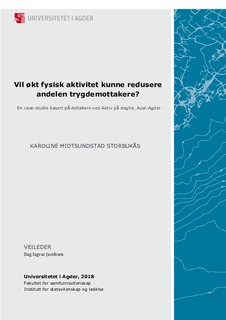| dc.contributor.author | Storbukås, Karoline Midtsundstad | |
| dc.date.accessioned | 2019-01-14T10:33:39Z | |
| dc.date.available | 2019-01-14T10:33:39Z | |
| dc.date.issued | 2018 | |
| dc.identifier.uri | http://hdl.handle.net/11250/2580446 | |
| dc.description | Masteroppgave offentlig politikk og ledelse ME502 - Universitetet i Agder 2018 | nb_NO |
| dc.description.abstract | This study is based on Aktiv pådagtid as an case study. The purpose of this study is to investigate the relationship between increased participation in physical activities directed by Aktiv på dagtid and the participants status in relation to working life. To better understand the relationship between these two variables, the study include three possible predictors:health, social support and self-efficacy.Thisstudy use a paper-based survey with 144 respondents, which represent the participants atAktiv på dagtid, who are at theage between 16-70, receive social security benefits and resides in the municipalities of Arendal, Grimstad, Lillesand or Risør.The results of thestudys mediating analysis indicate that the explanation variable 'change in health' mediates the relationship between participants 'degree of participation' and their 'change in status in relation to working life'. The increased ’degree of participation’ in Aktiv på dagtid is positively related to participants 'change in health' (b = .18, p <.05), but an improvementin participants ’change in health’ is negatively related to their ’status relative to working life’ (b = -.20, p <.05).Aktiv på dagtid turns out to have an opposite effect on participants ’status in relation to working life’, than what the study expected. Based on the findings, the study posesaquestions according to whether Aktiv på dagtid works against its purpose, and can be said to maintain the participants exclusion from working lifeinsted of helping its participants to return to work.Keywords: Sickleave, social security benefits, Aktiv på dagtid, NAV, physical activity, return to work, health, social support, self-efficacy | nb_NO |
| dc.language.iso | nob | nb_NO |
| dc.publisher | Universitetet i Agder ; University of Agder | nb_NO |
| dc.rights | Attribution-NonCommercial-NoDerivatives 4.0 Internasjonal | * |
| dc.rights.uri | http://creativecommons.org/licenses/by-nc-nd/4.0/deed.no | * |
| dc.subject | ME502 | nb_NO |
| dc.subject | Sickleave | nb_NO |
| dc.subject | social security benefits | nb_NO |
| dc.subject | Aktiv på dagtid | nb_NO |
| dc.subject | NAV | nb_NO |
| dc.subject | physical activity | nb_NO |
| dc.subject | return to work | nb_NO |
| dc.subject | health | nb_NO |
| dc.subject | social support | nb_NO |
| dc.subject | self-efficacy | nb_NO |
| dc.subject | Sykefravær | nb_NO |
| dc.subject | trygdeytelser | nb_NO |
| dc.subject | arbeidsmarkedstiltak | nb_NO |
| dc.subject | fysisk aktivitet | nb_NO |
| dc.subject | returnering til arbeidslivet | nb_NO |
| dc.subject | helse | nb_NO |
| dc.subject | opplevd sosial støtte | nb_NO |
| dc.title | Vil økt fysisk aktivitet kunne redusere andelen trygdemottakere? : En case-studie basert på deltakere ved Aktiv på dagtid, Aust-Agder | nb_NO |
| dc.type | Master thesis | nb_NO |
| dc.subject.nsi | VDP::Samfunnsvitenskap: 200::Statsvitenskap og organisasjonsteori: 240::Offentlig og privat administrasjon: 242 | nb_NO |
| dc.subject.nsi | VDP::Samfunnsvitenskap: 200::Samfunnsvitenskapelige idrettsfag: 330 | nb_NO |
| dc.source.pagenumber | 89 s. | nb_NO |

